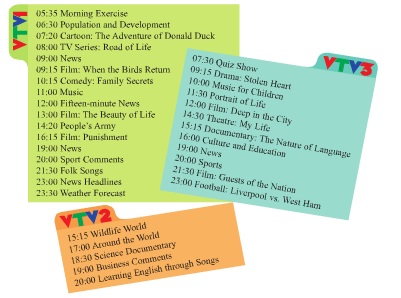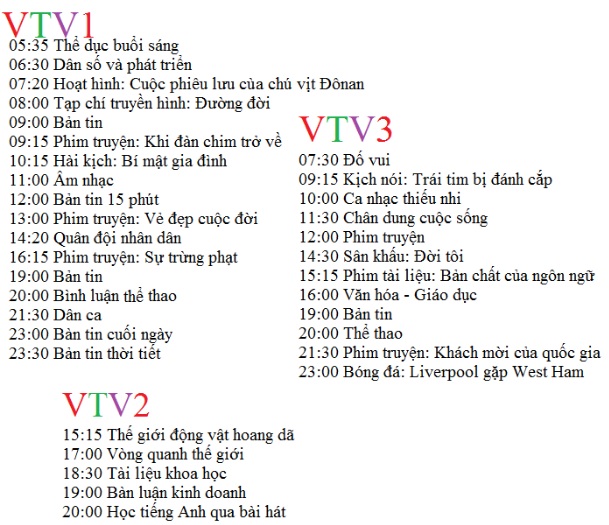Unit 7 lớp 10 Reading - Bài dịch The Mass Media
Tóm tắt bài
1. Before You Read Unit 7 Lớp 10
Work with a partner. Ask and answer the following questions. (Làm việc với bạn học. Hỏi và trả lời các câu hỏi sau.)
1. When do you often watch TV? (Bạn thường xem tivi vào khi nào?)
2. How many channels are there on our national TV? (Đài truyền hình quốc gia của chúng ta có bao nhiêu kênh?)
3. How many hours per week do you watch TV? (Bạn xem tivi bao nhiêu giờ mỗi tuần?)
Guide to answer
1. I often watch TV after dinner.
2. Besides the channels of national TV Stations and HCM City TV channels, nearly every province has its own television station.
3. I usually watch TV about nine hours per week.
2. While You Read Unit 7 Lớp 10
Look at some popular programmes, and then do the tasks that follow. (Nhìn vào các chương trình phổ biến, và sau đó làm các bài tập theo sau.)

2.1. Unit 7 Lớp 10 Reading Task 1
The words in A appear in the reading passage. Match them with their definitions in B. (Những từ ở A xuất hiện trong bài đọc. Ghép chúng với định nghĩa ở B.)
| A | B |
|
1. cartoon 2. drama 3. comedy 4. documentary |
a. a play for the theatre, television or radio b. a film or a television programme giving facts about something c. a film made by photographing a series of changing drawings d. a film or a play that is intended to be funny, usually with a happy ending |
Guide to answer
1 - c
2 - a
3 - d
4 - b
cartoon: phim hoạt hình
comedy: phim hài kịch
drama: kịch, tuồng
documentary: phim tài liệu
2.2. Unit 7 Lớp 10 Reading Task 2
Decide whether the following statements are true (T) or false (F). Correct the false information. (Xác định xem những phát biểu sau là đúng(T) hay sai (F). Sửa thông tin sai.)
1. There are five news programmes on the three channels.
2. There is a comedy programme on between 10:15 and 11:00
3. The Nature of Language is a documentary programme at 15:15 on VTV2.
4. The film Punishment is shown at 4:15 p.m on VTV1
5. VTV starts at 5:35 and ends at 23:30.
Guide to answer
1. T
2. T
3. F
=> The nature of language is the documentary programme at 15:15 on VTV3.
4. T
5. F
=> VTV1 starts at 5:35 and the last programme starts at 23:30.
2.3. Unit 7 Lớp 10 Reading Task 3
Work in pairs. Ask and answer the following questions. (Làm việc theo cặp. Hỏi và trả lời các câu hỏi sau.)
1. How many films are on? (Có bao nhiêu phim được chiếu?)
2. What time can you watch the news? (Bạn có thể xem tin tức vào thời gian nào?)
3. Which chanel do you recommend to someone who like annimals? (Bạn sẽ gợi ý kênh nào cho ai đó yêu động vật?)
4. What programme is on on VTV3 at 7:30? (Chương trình nào có trên VTV3 vào lúc 7 giờ 30?)
5. Which channel will you watch if you like folk songs? (Bạn sẽ xem kênh nào nếu bạn thích dân ca?)
6. What is the last programme on VTV3? (Chương trình cuối cùng trên VTV3 là chương trình gì?)
Guide to answer
1. Five films are on.
2. I can watch the news at 9:00, 12:00 noon; 19:00 and 23:00 on VTV1 and at 19:00 on VTV3.
3. VTV2
4. The programme on VTV3 at 7:30 is the "Quiz Show".
5. You should watch VTV1 at 21:30.
6. The last programme on VTV3 is the "Football".
3. After You Read Unit 7 Lớp 10
Work in pairs. Tell your partner about one of the TV programmes you like watching best and explain why. (Làm việc theo cặp. Hãy kể cho bạn học với em về một trong những chương trình truyền hình em thích xem nhất và giải thích tại sao.)
Guide to answer
I like watching the programmes such as the "Wildlife World" and "Culture and Education" best, because these programmes provide me with the knowledge of the life of wild animals and of the matters of various cultures and of education in our country and around the world. Thanks to these. I can broaden the horizon of my knowledge.
4. Bài dịch Reading Unit 7 Lớp 10

Read the following passage carefully, and then select the best option A, B, C or D to complete it:
WORLD WIDE WEB
World Wide Web (WWW), computer-based (1) _______ of information resources that combines text and multimedia. The information on the World Wide Web can be accessed and searched through the (2) _______, a global computer network. The World Wide Web is often (3) _______ to simply as “the Web.”
The Web started to become a (4) _______ resource after 1993 when the first widely distributed browser provided a convenient way to (5) _______ a variety of information on the Internet. The Web uses (6) _______, which means that information can be displayed in a wide variety of formats. (7) _______ can read text, view pictures, watch animation, listen to sounds, and even explore interactive virtual environments on the Web. A user can (8) _______ seamlessly from a document or Web page stored on the computer to a document or Web page (9) _______ on another computer.
The Web offers a place where companies, universities and (10) _______ institutions, and individuals can display information about their products, services, facilities, or research, or their (11) _______ lives. Only a small percentage of information on the (12) _______ is restricted to subscribers or other authorized users. The majority of Web pages are available to (13) _______ who can access a computer that connects to the Internet. The Web has become a (14) _______ for many companies selling products or services, and a forum for people to exchange opinions and information. Museums, libraries, government agencies, and schools post information on the Web to make it (15) _______ to others.
New vocabulary:
- seamless (adj.): không có đường nối, liền một mãnh
- institution (n.): cơ quan, trụ sở cơ quan
- restrict (v.): hạn chế, giới hạn, thu hẹp
- subscriber (n.): người đặt mua, người đăng nhập
1/ A. system B. source C. network D. resource
2/ A. Computer B. Radio C. Television D. Internet
3/ A. said B. referred C. told D. considered
4/ A. popular B. normal C. ordinary D. favorite
5/ A. enter B. access C. come into D. arrive at
6/ A. yahoo B. Media Player C. information D. multimedia
7/ A. Users B. People C. Customers D. Shop keepers
8/ A. go B. move C. fly D. run
9/ A. placed B. put C. installed D. stored
10/ A. another B. others C. other D. one another
11/ A. private B. popular C. common D. possessive
12/ A. Computer B. Network C. System D. Web
13/ A. no one B. everyone C. someone D. anyone
14/ A. school B. hospital C. marketplace D. company
15/ A. good B. available C. free D. valuable
Key
1/ C. network ; 2/ D. Internet ; 3/ B. referred ; 4/ A. popular
5/ B. access ; 6/ D. multimedia ; 7/ A. Users ; 8/ B. move
9/ D. stored ; 10/ C. other ; 11/ A. private ; 12/ D. Web
13/ D. anyone ; 14/ C. marketplace ; 15/ B. available
Bài tập trắc nghiệm Reading Unit 7 Lớp 10
Như vậy các em vừa xem qua bài học Reading Unit 7 tiếng Anh lớp 10 và thực hành làm bài tập minh họa. Để củng cố và rèn luyện kỹ năng đọc hiểu mời các em tham gia thực hành Trắc nghiệm Unit 7 lớp 10 Reading
-
Câu 1: Read the passage below carefully, and then select the correct option A, B, C or D The World Wide Web was developed by British physicist and computer scientist Timothy Berners-Lee as a project within the European Organization for Nuclear Research (CERN) in Geneva, Switzerland. Berners-Lee combined several existing ideas into a single system to make it easier for physicists to use data on the Internet. Most important, he added multimedia—the ability to include graphics—to the hyperlink concept found in a previous Internet service known as gopher. Berners-Lee had begun working with hypertext in the early 1980s. An early prototype implementation of the Web became operational at CERN in 1989, and the idea quickly spread to universities in the rest of the world. Groups at the National Center for Supercomputing Applications at the University of Illinois at Urbana-Champaign researched and extended Web technology. They developed the first browser that was used at many sites, named Mosaic, in 1993. To allow the Web to be accessed from a wide variety of computer systems, researchers built multiple versions of Mosaic. Each version was designed to be used with a specific operating system, the software that controls the computer. Within a year, computer programmer Marc Andreessen had formed a commercial company, Netscape Communications Corporation, to build and sell Web technologies.
The World Wide Web was developed by .........
- A. an American
- B. a British
- C. a Canadian
- D. a French
-
- A. math and physics
- B. math and computer
- C. computer and physics
- D. math, physics and computer
-
- A. Timothy Berners-Lee spoke English very well.
- B. Timothy Berners-Lee was born in Geneva, Switzerland.
- C. Timothy Berners-Lee was the first person to develop WWW.
- D. Some existing ideas were combined into a single system by him.
Câu 2 - Câu 10: Xem trắc nghiệm để thi online
Trong quá trình học bài và thực hành trắc nghiệm đọc hiểu có điểm nào còn thắc mắc các em có thể đặt câu hỏi trong mục Hỏi đáp để được sự hỗ trợ từ cộng đồng HOCTAP247. Chúc các em học tốt!
Bạn có biết?
Tiếng Anh hay Anh Ngữ (English /ˈɪŋɡlɪʃ/ ) là một ngôn ngữ German Tây, được nói từ thời thời Trung cổ tại Anh, ngày nay là lingua franca toàn cầu.Từ English bắt nguồn từ Angle, một trong những bộ tộc German đã di cư đến Anh (chính từ "Angle" lại bắt nguồn từ bán đảo Anglia (Angeln) bên biển Balt)
Nguồn : Wikipedia - Bách khoa toàn thưTâm sự Lớp 10
Lớp 10 - Năm thứ nhất ở cấp trung học phổ thông, năm đầu tiên nên có nhiều bạn bè mới đến từ những nơi xa hơn vì ngôi trường mới lại mỗi lúc lại xa nhà mình hơn. Được biết bên ngoài kia là một thế giới mới to và nhiều điều thú vị, một trang mới đang chò đợi chúng ta.
Nguồn : ADMIN :))Copyright © 2021 HOCTAPSGK
